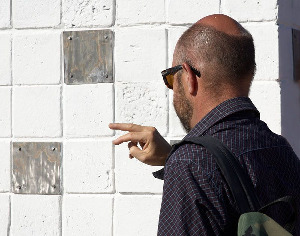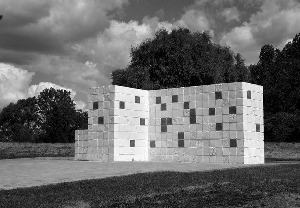I finally got into NY yesterday to see my friend Jack Sal’s exhibit at Zone Contemporary, a new gallery on 57th St that opened with his show this January. It was a whirlwind trip that ended with a very brief visit with pal Ali Hossaini in the West Village. Next visit will be to pick up his high res printer that he’s kindly lending to me. Note to self; searching for parking with a pickup truck on a weekday in Manhattan is a duel with absurdity.
While I’m not much of a conceptual afficionado and usually respond more to paintings, these works and Jack’s articulation of his intent made them meaningful for me. The elegant exhibit perfectly fits the newly renovated space that has shown artists Pat Steir, John Cage, Ruth Kligman – among others.
Sal’s early work, reminiscent of Mark Tobey‘s interest in the pictography and spirituality of calligraphy, reminded me a little of Egyptian hieroglyphs. When I asked him about that, he noted at the time he created these works, he was studying Talmudic texts.
Other earlier works include cliché-verre photographs and beautifully marbled, small lead plates derived from a permanent exhibit in Kielce, Poland, that Sal created in homage to the 42 victims of a 1946 massacre there. In the site exhibit, the lead plates are attached randomly to the monument, a visual representation of the date, street and physical shape of the original building where the massacred Jews had lived.
An insightful interview by Tom Butter in White Hot Magazine accompanies the show, excerpts here with photos from the exhibit below.
TB:Â So by applying the same elements to different situations, your intent is to illuminate the various situations.
JS: Yes, I think that is what one does in all one’s activities. You use your sense of self, and your sense of thought and you apply them to all your activities.
TB: But this is not exactly the modernist program.
JS: No, and that is part of the collapse of modernism-which is a democracy of language, but not a democracy of intent. This is where it breaks down. As an artist, one has to accept history, but not the consequences. Even within aesthetics or concepts within art, you can accept, be interested in, and apply, the ideas of modernism, but not necessarily accept the conclusions. Hopefully you will be able to break out and expand the vocabulary.
———
TB: Well art goes on, it continues. But aren’t you talking about inserting something that is subversive?
JS: What I am doing questions the permanency of things. Our experience in the 20-21st centuries is that we recognize and acknowledge the ephemeral qualities of life. Part of the problem of modernism is that it tries to arrest the ephemeral. Ironically, sometimes the best touchstone of that ephemeral quality is the very permanency that modernism proposes. I’m trying to make things that look as if they are in the legacy of modernist iconography, while they are actually changing in front of your eyes. Either they are changing because they have physical qualities that when you move they change, like the way the tape does on the large pieces, or when you are looking at a painting but then realize the space between them is a drawing although it isn’t made like a drawing; suddenly the space becomes line, which is a division.Â
Without sounding too self-referential, the idea of using panels like this not only comes from modernism, but also comes from spending time in Italy, and looking at Renaissance, and pre-Renaissance panel painting. I live part of the year close to Assisi, where the Giotto’s are. The Franciscans implemented the use of a panel-narrative style. Understanding that many people were illiterate, they used methods of preaching through illustration. There was an emphasis on episodic events in sequence. The connection between them comes from a kind of program. So the format of things is not the by-product of architectural structure, they do not serve as decoration. Programming is part of the language- in this case, it serves a dogma. Painting is not used merely as illustrative means of depicting a story- but by its very framing, its presentation it is used to direct a certain point of view, a certain program.
Â












